Introduction
Ever since the Prime Minister of India Sri Narendra Modi, while chairing a review meeting on Indus Water Treaty-1960 (IWT), reportedly made that famous statement post the Uri terrorist attack on 16 Sep 2016, that ‘blood and water could not flow simultaneously’1, a debate has been going on in India as to whether the IWT should continue as hither to fore or should it be reviewed for necessary course corrections.
In this regard the tone was set by the Prime Minister himself while ad-dressing a rally at Bhatinda, on the eve of Heart of Asia Meet in Amritsar during November 2016. He said, “The Indus Waters; India has right to those waters…. it flows into Pakistan, flowing through the Pakistan, the wa-ter goes into the sea. That water belongs to Indian farmers. We will do whatever we can; to give enough water to our farmers”.2 The response from Pakistan was on expected lines. It was articulated by Sartaj Aziz, Adviser to the Prime Minister of Pakistan on Foreign Affairs, when he said that the revocation of the Indus Waters Treaty by India "can be taken as an act of war" against Pakistan.3
Government of India has set up a high level inter-ministerial Task Force headed by the Principal Secretary to Prime Minister, Sri Nripendra Mishra, to look into all the strategic aspects of the IWT with Pakistan. Members of this Task Force include: the National Security Advisor (NSA) Sri Ajit Doval, Foreign Secretary and Secretaries in the Ministries of Finance, Environ-ment, Power and Water Resources. Besides permanent members, Chief Secretaries of Jammu and Kashmir (J&K) and Punjab have been designated as permanent invitees to the deliberations of the Task Force. The Task Force has been mandated to take all important strategic and policy deci-sions. In its first meeting itself, it was decided that India would harness maximum waters of Pakistan assigned Rivers (Indus, Chenab and Jhelum) as entitled under the provisions of the IWT.4
This paper to examines the various policy options in response to that stated intent with a view to identify the most workable option which would be in the best interests of the country.
Current Status
In last one year there has been a lot of discussion on whether the IWT should be replaced by a policy wherein waters of Indus and other Western Rivers are stopped totally, or should India continue with the current policy of following IWT, continue to go slow on proposed projects that conform to its provisions and allow much of the waters permissible to India to flow in-to Pakistan as hither to fore? Alternately, should India, without abrogating the Treaty, progress those projects to ensure that the waters of Eastern and Western Rivers, as permissible to India, are utilised and not allowed to flow out into Pakistan?
Option I: India Abrogates the Treaty and Stops the Waters from Flowing into Pakistan
This option which appears simplistic; it has many issues which are actual-ly not that simple. Issues entailed are as follows:-
- It may amount to a Human Rights violation case. Water and sanitation was recognised as a human right by the United Nations General Assembly on 28 Jul 2010.5 Some commenta-tors have derived the rights to water further from Article 11.1 of the International Covenant on Economic, Social and Cultural Rights mak-ing it binding under International Law.6
- More than anything else, India as it is finds it difficult to store about 3 MAF of the waters of the Eastern Rivers (Ravi, Sutlej and Beas) which leak out into Pakistan from the tributaries of Ravi River downstream of Madhopur and Firozpur Headworks. On top of it, if she plans to stop waters from the Western Rivers (Indus, Jhelum and Chenab) which is approximately 180 MAF, she will find it almost an impossible task in view of the inadequate storage capacity on these rivers.
- Another aspect in this connection which needs to be considered is that this approach may amount to violation of the ‘UN Convention on the Law of the Non-Navigational uses of International Water Courses’. After 23 years of preparatory work by the International Law Commis-sion (ILC) and extensive deliberations by the General Assembly, this Convention was adopted by the United Nations General assembly on 21 May 1997. There were 103 countries who voted for the motion, three countries voted against, 27 abstained and 52 countries did not participate in the voting. China was one of the three countries which opposed the motion. However, this Convention has yet to enter into force and effect because it has so far been ratified only by 16 coun-tries. 7 Thus, though it may not be a legally binding Convention, but morally it needs to be respected, particularly in view of water and sanitation having been recognised as a human right by the Millennium Development Goals8.
- It may be noted that in the light of its opposition to the Convention of 1997, any unilateral action on the part of China to divert waters from the Rivers Indus and Sutlej in West and Brahmaputra in East, without caring for the lower riparian states, would have a major bear-ing on the water availability to India and Pakistan in the West and In-dia and Bangladesh in the East respectively.9
Some of the examples of China’s apathy towards water rights of the lower riparian’s are evident from following examples:-
- China recently declared that she was blocking the Xiabuqu River, one of the tributaries of the Yarlung Zangbo (Brahmaputra) to build a dam as part of the Lalho Hydroelectric Project at Xigase in the Tibet Autonomous Region.10
- China has constructed a medium scale dam on River Indus, few miles Eastward of Ali which is the capital of Ngari Prefecture of Tibet Autonomous Region. This place is quite close to Demchok, Ladakh. Ini-tially it will generate 11 MW of power which will be upscaled to dou-ble of its original capacity in due course of time. It will practically stop most of the flow downstream of the Dam and will cause water short-age for mega hydroelectric projects at Tarbela in Pakistan. 11 It needs to be noted that China has built this Dam without any pre-warning to India and Pakistan. Pakistan is raising no issue because of the financial support it expects from China. However, in this case India needs to make it clear to Pakistan that shortage of water in Indus down stream of this Dam is affecting not only India but also Gilgit Baltistan region of the Pakistan Occupied Kashmir (PoK), both for irrigation and power generation.
- China has also constructed a barrage on Sutlej in the Zada Prefec-ture in Western Tibet. It will control water of Sutlej coming to India with adverse impacts on power generation as well as irrigation po-tential in Himachal Pradesh in India.12
Such structures also provide China options to use water as weapon, should she so desire in case of a future conflict.
In view of the above discussion this option does not seem to be advisable because: firstly, it will show that India is not a responsible state and does not respect its international commitments; secondly, India will be going against the UN Convention of 1997 and affecting the human rights of a lower riparian state which again is not worthy of a responsible country like India; thirdly; India will not only cease to have moral authority to chal-lenge China on her violation of the UN Convention but will have to be pre-pared to face China’s hostile acts of denial of water from Brahmaputra in East and Sutlej in West. It also needs to be appreciated that creation of new storage capacity for the water flowing into Pakistan is quite a complex task, two of the major complexities being the difficulties in land acquisition and that it would be a time consuming exercise. Therefore, this option is likely to remain a non- starter for a sufficiently long time.
Option-2: Status Quo Ante to be Maintained
Implication of implementation of this option would mean that:-
- Waters from four tributaries of River Ravi, namely, Basantar, Bein, Tarnah and Ujh downstream of Madhopur Headworks, though forming part of India’s share of 33 MAF from the Eastern Rivers, is al-lowed to continue flowing into Pakistan.
- Also, from the Western Rivers, part of water which India is enti-tled to impound (a maximum of 3.6 MAF) but is presently not being impounded, is also allowed to go to Pakistan. Of the 1.34 million acres permitted for irrigation India continues to use only 0.792 million acres.13
- Hydro-electricity projects which can help India to generate to the tune of 18652 MW from the Western Rivers are not progressed. It may be noted that of this capacity, projects worth only 2324 MW are ready and projects worth 659 MW are in various stages of construc-tion. 14If we go by the premise of this option, the pro-jects under construction will have to stop and new projects which In-dia could take up as part of its entitlement as provided by the IWT will not be taken up.
While this is one option, which Pakistan may want India to continue with, but as a quid pro quo it is not doing enough to assure India that the terrorist related activities being planned and executed from its soil will no further be encouraged. In fact, post the Uri terror attack, incidents like Nagrota attack have happened. Besides, most of the surplus waters over and above the IWT scaling which is flowing into Pakistan are either being used to fill up its defence oriented ditches and canals, or a lot of it is getting wasted out for the following reasons:-
- Storage capacity of Pakistan is just 30 days as compared to India’s 190 days, as per the Indus River System Authority (IR-SA)15.
- Ground Water in Pakistan is depleting fast and probably the Gov-ernment is doing nothing to ameliorate the situation.16 In fact, by an estimate, 65.7 BCM of water gets into the aquifer to re-charge it, but out of that only 49.3 BCM gets concurrently used up, 17 Thus leaving very little to recharge the aquifer.
- Surface water is the primary source of water in Pakistan. Out of 180 BCM which Pakistan gets every year, although almost 75 per cent of the surface water is diverted to the canal heads but only 30 per cent reaches the crop due to seepage and evapora-tion.18
- 38 MAF of water gets wasted out every year by getting drained in-to the sea.19
Factors Related to Option 2
Effect of Global Warming and Climate Change on the Availability of Water in the Indus River Basin (IRB)
The rivers in IRB are mostly glacier fed. The dependence of feed into the Western rivers of IRB is as tabulated below:-
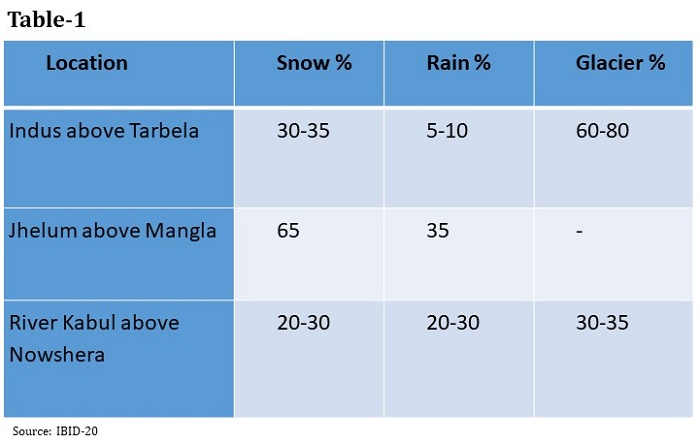
Above table clearly brings out the importance of snow and health of glaci-ers in sustaining water availability in rivers of Pakistan. In this connection it is important to note that the International Centre for Integrated Moun-tain Development (ICIMOD) have brought out in their studies that the glac-iers in Western Himalayas are retreating,20 and in central part of the Upper Indus Basin in the Karakoram Range these are advanc-ing. This phenomenon is known as ‘Karakoram Anomaly’, believed to be caused due to a vortex of trapped cold air that circulates through the Kara-koram mountains, preventing them from getting heated. Combined with the South Asian monsoon, this large scale circulation system counteracts the summer warming of the rest of Himalayas, causing the Karakoram Range to remain cool while other areas get warmer.21 Such a scenario suggests that though right now the quantum of water from glac-iers may not be reducing but in future a possibility of reduced water avail-ability in the Western Rivers does exist. In this connection following devel-opments need to be taken note of:-
- The Kolahoi, Kashmir’s biggest glacier and main source of wa-ter in Jhelum River is melting faster over the past one decade as com-pared to other Himalayan glaciers.22
- Siachen Glacier, which is a source of water into Nubra and Shyok Rivers, has shrunk by 1.7 km in 17 years.23
It has been estimated that for the next 50 years glaciers will continue to re-treat. Faster melting will result in increased flow in the rivers but in 100 years it will drop to 30-40 per cent of the current flow. This effect has al-ready started manifesting in the form of reduced flow in the Western Riv-ers. It may be noted that in the Western Rivers, flow of 119 MAF in 1960 has already come down to 102 MAF in 2011.24 As has been explained at Table-1 above, water in River Indus is substantially due to glacier melt and accumulated snow which are highly vulnerable to global warming. It is appreciated that between 2046 and 2065, availability of wa-ter for irrigation will become scarcer due to accelerated melting of snow.25
In the final analysis, probably in short-term, agriculture and tourism will be benefitted, but in the long-term water supply in general and in Sindh in particular will be adversely affected. A German think tank has stated in a study that Pakistan is the seventh most vulnerable country in the world to climate change. Pakistan needs to start working on getting all the glaciers declared as protected areas. Since the glaciers are located in such a way that these may not be limited to one country, the work for their preserva-tion should be taken up under the aegis of the UN by the creation of an in-dependent international glacier preservation authority with the mandate applicable to specific areas.
Effect of Pollution on the Water Quality
At the moment, the Northern part of Pakistan has micro-biological con-tamination of 64 per cent (diagnostic survey, 2007), and its Central part has both micro-biological and chemical contamination.26 Most prominent contaminants comprise of dyes, chromium, fluorides, iron which not only pollute the surface water but also have potential to contam-inate ground water resources. In addition to the abovementioned contam-inants, the Central and Southern parts of the country are also experiencing prevalence of heavy concentration of Arsenic and Nitrates in the soil, which have rendered the ground water substantially contaminated. It is es-timated that only 79 percent area of the Punjab and 28 percent area of Sindh is suitable for ground water based irrigation.27
Miscellaneous Factors
Impact of Deforestation.
According to UN Food and Agricul-ture Organisation (FAO), only 2.2 per cent of Pakistan is forested. Between 1990 and 2010, Pakistan has lost as much as 33.2 per cent of its forest cover. 28 Upper Indus Basin has only 0.4 percent of the total forest cover.29Lack of forest cover results in top soil getting washed away as a result of rainfall. The washed away soil causes silting of rivers and degradation of water bodies.
Population Growth.
Pakistan has one of the highest popula-tion growth in the region. The Country’s population grew four times dur-ing the period 1950-2011. During the period 1998-2017, the population growth has been 2.4 percent, which is still the highest in the South Asian region. 30 Without any accretion of potable water availabil-ity, such a growth is adding to the water problems of Pakistan. Gap be-tween demand and supply of water which was four per cent in 2011 is likely to become 31 per cent in 202531. Water availability per capita per annum was 1066 cu m in 2010 which is likely to reduce to 875 cu m in 2025 and by 2050 it is likely to go down to 700 cu m which will make Pakistan a ‘Water Scarce’ country.
Exploitation of River Kabul by Afghanistan.
River Kabul which joins River Indus from West at Attock is a major source of water into the latter. Any reduction in the quantity of water from River Kabul into the River Indus will adversely affect the water availability in lower reaches of Indus, with serious implications on food security of Pakistan. In this con-nection it is relevant to note that Afghanistan is experiencing 60 per cent drop in rain and snowfall which are needed for good agricultural produc-tion. To ensure water availability for the crops round the year, Afghani-stan is trying to build a number of dams on River Kabul. One of those dams, named Shahtoot Dam on River Maidan, a tributary of the Kabul River, is coming up in the Chahar Asaib district of Kabul. The work is scheduled to begin soon. It will hold 146 million cu m of water. This Dam is causing ten-sion in Pakistan as it will alter the flow of the Kabul River into Pakistan. The DAWN has reported that there could be a 16-17 per cent drop in water flow. Besides reducing water flow to Pakistan, the Shahtoot Dam is a cause of tension because of its funding from India. Pakistan feels that the dam is part of Indian design to strangle Pakistan’s limited water supply. Her ap-prehension is based on the fact that India has assisted Afghanistan with feasibility studies on a total of 12 dams on the Kabul River, which would generate 1177 MW but will further reduce the flow of water into Paki-stan.32
Water Intensive Utilisation.
Pakistan has World’s fourth highest rate of water usage. Its water intensity rate per unit GDP is the highest in the world. As per an IMF Report, Pakistan’s per capita annual water availability is 1017 cu m, perilously close to the scarcity threshold of 1000 cu m. It may be noted that in 2009 it was 1500 cu m, which shows that the availability of water is steadily reducing. To substantiate this ob-servation, the IMF Report further adds that Pakistan currently ranks third in the world among the countries facing acute water shortage. Besides population growth, one of the major reason is irrigation, as Pakistan is still a highly agrarian economy. 33 Pakistan is likely to reach ab-solute water scarcity by 2025.
Uneven Distribution of Water and Interstate Problems.
Insufficient flow in River Indus in the lower reaches has led to sea intru-sion into its estuary. In fact, sea water has intruded up to as much as 87 kms due to lower or no flow. 34 A number of projects, like Kalabagh, Bhasha Diamar, Chilas are being resisted by locals. Similarly rais-ing of height of Mangla Dam is being resisted by the people of PoK. While considering demands of the water for PoK, it needs to be flagged that the Indus River System Authority (IRSA) has refused release of water on grounds that PoK, which Pakistan call Azad Kasmir, is neither a signatory to the IWT nor that of the Water Appropriation Accord (WAA) of 1991.35 All this clearly reflect on Pakistan’s lack of commit-ment for Kashmiris, and that Pakistan treats the J&K’s resources as its own.
Thus Option 2 may be a reflection on the indifference on the part of those in Pakistan who are entrusted to ensure that national interests as en-shrined in the IWT provisions are protected. The discussion also clearly brings out that water problems are substantially due to climate change and mismanagement of water issues by Pakistan. Pakistan’s blaming India for its water problems is a mis-interpretation of the provisions of the IWT. It also emerges that one of the important interests of Pakistan in Kashmir is its water resources.
Option -3: India does not Violate the IWT but goes ahead with Plans to Fully Utilise the Waters Entitled by the Treaty
India is well within her rights under the provisions of the IWT to fully stop the leakages from the Eastern Rivers which is approximately 3 MAF, and make efforts to impound 3.6 MAF from the Western Rivers as entitled by the provisions of the IWT. Exercise of that right cannot invite differ-ences with the World Bank which stood guarantee to the IWT, nor will it leave any scope for the world opinion to allege violation of the rights of lower riparian states as provided under the provisions of the ‘UN Conven-tion of 1997 on International Channels’.
It also needs to be appreciated that India needs to harness the hydro-electric potentials of the Western Rivers, as entitled to her within the pro-visions of the IWT, to ensure that the power requirement of the State of J&K are fully met. Currently, out of a potential of 18653 MW only 2324 MW is being exploited and therefore it would be in fitness of things that India creates the necessary infrastructure to store the water to the extent of her entitlements and generates hydro-electricity as provided in the IWT. India has planned 21 projects on Chenab, 13 projects on Jhelum and Up-per Sind (Ganderbal) Phase 2 project 36. Most of these are hydro-electric projects and by no stretch of imagination these are meant to store water more than what is permissible.
Pakistan’s Obduracy
Pakistan questions 27 of India’s legitimate projects on Western Riv-ers37. Syed Jamat Ali Shah, Pakistan’s Commissioner for In-dus Water, claims that a total of 43 million cu m of water flowing into Paki-stan is likely to get blocked once these projects are complet-ed38. While the figure itself is debatable, but more im-portantly, the ponding does not exceed India’s entitlement as provided by the IWT. It is interesting that in 2010, the same Syed Jamaat Ali Shah stated in a seminar organised by the Nawa-i-Waqt Group of News Papers that the storage under execution by India is well within her rights as per the provi-sions of the IWT (Article 32 of the IWT and the Annexure C of the Treaty). Although a number of speakers in the same seminar, and even subsequent-ly had been ascribing motives to Syed Jamaat Ali Shah, but the fact remains that no evidence has been provided by Pakistan to substantiate their charge. 39 May be Syed Jamat Ali Shah had realised that his earlier statement was not based on facts and as such had to speak the truth.
In fact, whenever Pakistan has gone to arbitration, neutral experts or the International Court of Justice (ICJ), every time India’s right to use waters of the Western Rivers for the purposes stipulated in the IWT has been up-held. Latest cases in point are decisions on Baghliar and Kisenganga Hydro-Electric Projects. Once again, Pakistan is expressing concerns about the de-signs of five Indian projects, namely, Pakal Dul (1000 MW), Ratle (330 MW), Kishanganga (330 MW, already completed), Lower Kalnai (48 MW), all in J&K, and Miyar Nallah (120 MW) in Himachal Pradesh. These are all in various stages of construction despite Pakistan’s objec-tions.40 It may be noted that Kishenganga Hydro-Electric Project has already got completed but is still being questioned by Pakistan. It is also relevant to note that the number of dams that India can construct on the Western Rivers is a grey area as far as IWT is concerned.

Figure-1: Existing/ under Construction/ Proposed Hydro Projects on Western Rivers : Red are those which have already completed, dark blue are those which are either under construction or are under planning, and light blue are those which would be taken up subsequently.
It is a fact that Pakistan is not doing enough to address its water crisis. Wa-ter is substantially used (almost 90 per cent) for irrigation and it is not taxed, which makes usage lavish - and no effort is being made to correct this state. Both, Tarbela and Mangla Reservoirs have reached their respec-tive dead levels due to excessive silting. Dredging of these reservoirs need to be given a serious thought. Another issue for low inflow into these res-ervoirs, as intimated by the IRSA, is that the unusually low temperatures in Skardu in PoK’s Gilgit Baltistan region have resulted in very low inflows into Tarbela and Mangla Dams which feed the canal system in Punjab and Sindh.
The next issue which Pakistan needs to tackle is the seepage from unlined canals which accounts for losses up to 40 per cent. It is also relevant to re-iterate that Pakistan has exceptionally low storage capacity (30 days) 41, which has adverse effect on irrigation during lean sea-son. One of the reasons for slow progress in creation of storage space is the corruption from which Water and Power Development Authority (WAP-DA), agency responsible for building up water related infrastructure, suf-fers (Transparency International Survey of 2003)42. Paki-stan needs to spend more on conservation of water resources and related infrastructure development with a view to cater for the futuristic require-ments. As per an IMF report, currently Pakistan spends only 0.25 % of the GDP on water resources.
The Way Ahead
In view of the above discussion, it is clear that it is imperative for India to utlise maximum out of her entitled waters from the Eastern as well as Western Rivers. In so doing, Pakistan’s inevitable rhetoric over the matter might have to be tackled diplomatically.
Shortage of water in Pakistan has very less to do with the provisions of the IWT. As such, its allegation that India is trying to usurp its share of water is not based on facts. Problems are either of its own making or are due to universal phenomenon of global warming. It is therefore essential that in-stead of blaming India, Pakistan needs to take necessary actions on its own to improve the water availability, conserve available potable water re-sources and optimise available water sources by leveraging technology and generating necessary awareness about management of water among its people so that the wastage is minimised.
References
- Indrani Bagchi and Viswa Mohan, “‘Blood and water can’t flow together’: PM Narendra Modi gets tough on Indus treaty”, The Times of India dated 27 Sep 2016.
- Dipanjan Roy Chaudhury, “Hinting at Pakistan Prime Minister Narendra Modi says Indus River Waters belong to Indian farmers”, published in The Economic Times, dated 26 November 2016.
- As reported in The DAWN, “Revocation of Indus Waters Treaty can be taken as an act of war: Sartaj Aziz”, dated 27 Sep 2016 and uploaded on dawn.com.
- “Task force to review Indus Water Treaty”, The Pioneer, dated 18 December 2016 | PNS | New Delhi, uploaded on dailypioneer.com
- Resolution 64/292: The Human Right to Water and Sanitation, Aug 2010.
- en.m.wikipedia.org
- AK Chaurvedi, “Water a Source of Future Conflicts”, Page-47, published by Vij Books India Pvt Ltd, May 2013.
- Resolution 64/292: The Human Right to Water and Sanitation United Nations dated August 2010.
- Ibid-7.
- PTI Report, “Government Forms High Level Task Force on Indus Water Treaty”, pub in Times of India dated 17 Dec 2016.
- Senge H Sering, “China Builds Dam on Indus near Ladakh “, pub in Journal of Defence Studies, Vol 4. No April 2010 , Page -136 and uploaded on idsa.com.
- Ibid-7 Page 185.
- Ibid-7, Page 175.
- Ibid-7, Page 175.
- Shahmir Baloch, “Water Crisi: Why is Pakistan running Dry” uploaded on dw.com
- Michael Klugelman, South Asia Expert at Washington based Woodrow Wilson Centre in an interview in 2015 told DW published by DW and uploaded on dw.com with the title “Water scarcity 'is Pakistan's worst night-mare”.
- Ibid-7, Page-124, source ACE/Halcrow, “Exploitation and Regulation of Ground Water June 2001.
- Ibid-7, Page- 124.
- Ibid-7, Page 174.
- Dr Shaheen Akhtar, “Trans boundary Water Cooperation in the Indus Basin: Challenges and Opportunities” presentation during Regional Workshop on Transboundary Water Cooperation in the Context of Sustainable Devel-opment Goals (SDGs) in South Asia and Beyond, Pokhara, Nepal dated 23-24 May 2017.
- Chris Fitch, “Glacial Growth: Cracking the Karakoram Anomaly”, pub in Mountains and uploaded on geograph-ical.co.uk/places/m.
- Reuters Report on Environment, “Kashmir's main glacier "melting at alarming speed” dated 12 Oct 2009 up-loaded on in.reuters.com
- Edited by Daniel Moran, “Climate Change and National Security: A Country-Level Analysis”, page -86, published by Georgetown University Press, dated Mar 2011.
- Ibid-20.
- Ibid-7 Page 109.
- Ibid-7 Page 126.
- Ibid-7 Page 126.
- rainforests.mangabay.com
- Ibid-20.
- Provisional Summary of 6th Population and Housing Census-2017: Pakistan Bureau of Statistics.
- Sehrish Wasif, “Water Supply, Demand Gap to Reach 31 % by 2025”, pub in The Express Tribune dated 18 Mar 2018, uploaded on tribune.com.pk
- Elizabeth Hessami, “Foreign Policy”, 13 Nov 2018.
- Shahmir Baloch, “Water Crisis: Why is Pakistan Running Dry?, uploaded on dw.com
- Aditi Phadnis, “Water Conflict in Kashmir”, pub in Business Standard dated 16 May 2005.
- Ibid-7, Page 144.
- Ibid-7 Page 167.
- Ibid-7 Page 165.
- Ibid-7 Page 168.
- Khaled Ahmed, “Target: Jamaat Ali Shah”, pub in The Express Tribune dated 02 Dec 2012.
- PTI Report, “Indus hydropower projects being built despite Pakistan's objections: Govt”, pub in Economic Times dated 29 Mar 2017.
- Ibid-15
- Seth G Jones et.al., “Securing Tyrants of Fostering Reforms? US Internal Security Assistance to Repressive and Transitioning Regimes”, page-134, pub by Rand Corporation during 2006.
(The paper is the author’s individual scholastic articulation. The author certifies that the article/paper is original in content, un-published and it has not been submitted for publication/web upload elsewhere, and that the facts and figures quoted are duly referenced, as needed, and are believed to be correct). (The paper does not necessari-ly represent the organisational stance... More >>
Image Source: https://mrunal.org/wp-content/uploads/2016/10/geography-indus-river.png

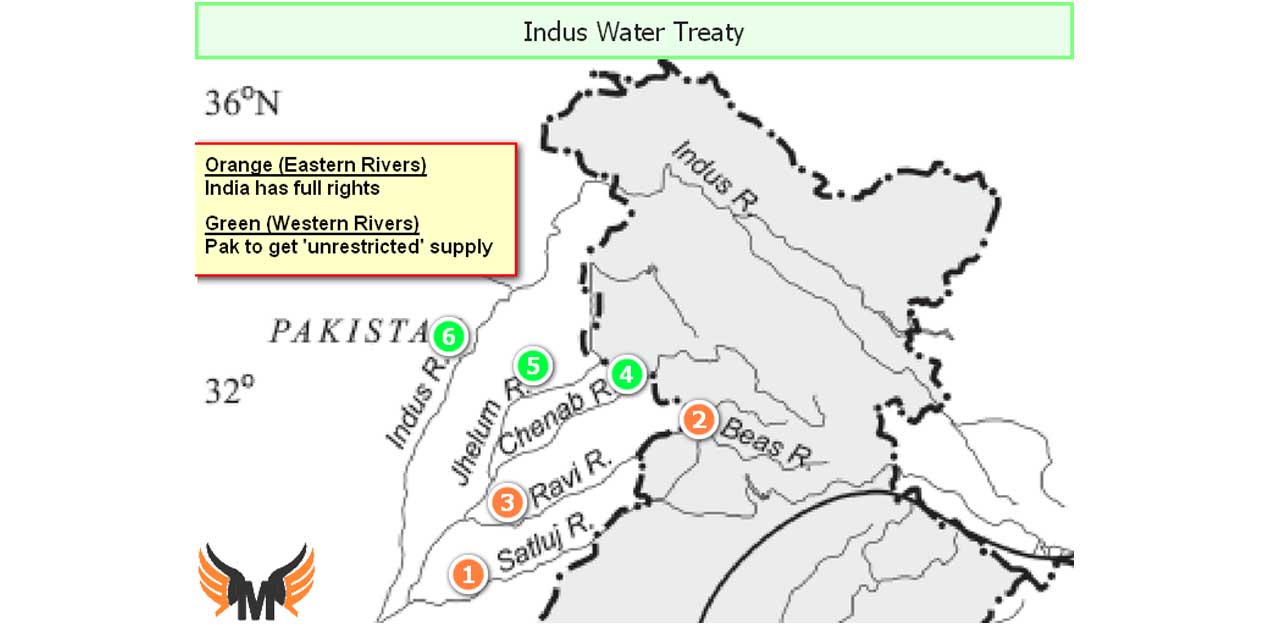

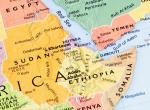

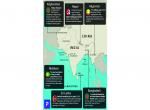
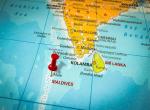




Post new comment